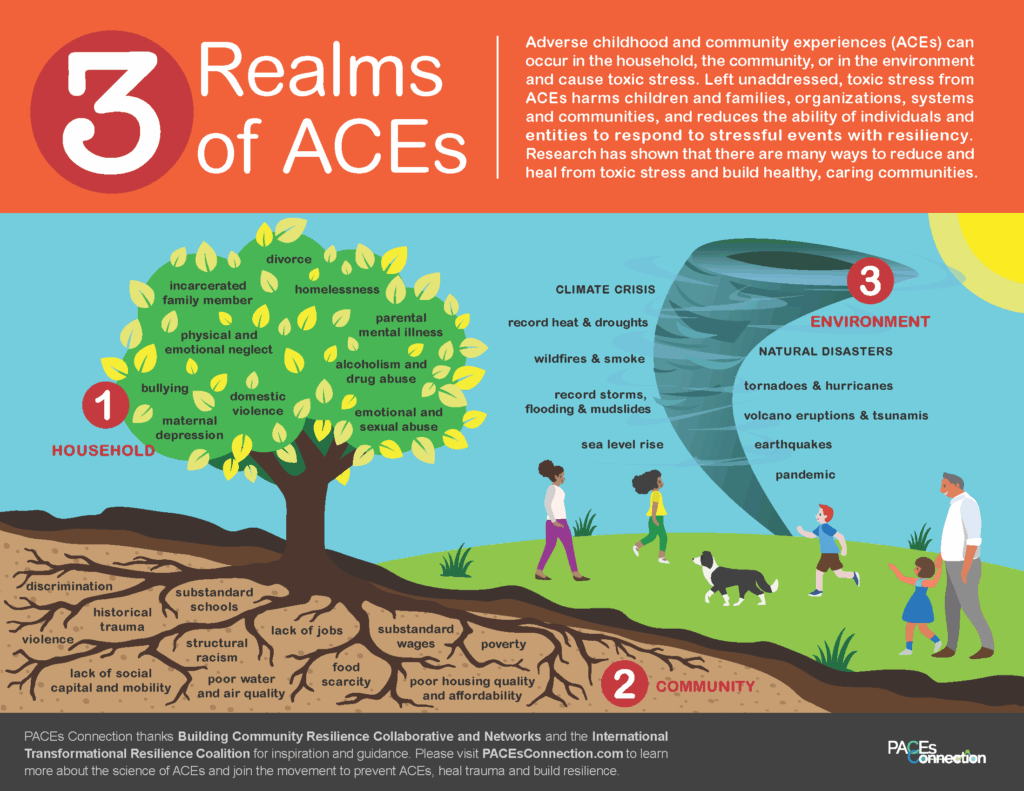64% of adults in the US have had adverse childhood experiences which may be negatively impacting their performance at work, as well as their health and current relationships. Research shows that even years after experiencing an adverse childhood experience (ACE), you may experience problems such as suboptimal work performance, challenges getting along with work colleagues, unstable work histories, and financial struggles, all tied to your childhood.
Adopting trauma-informed and resilience-building practices in our organizations can counter the impact of ACEs. And while these practices are very important for trauma survivors, they are universally good for every employee and company by creating a healthier and more resilience workplace.
What are ACEs?
Adverse Childhood Experiences (ACEs) are potentially traumatic events that occur before the age of 18 and can have a lasting impact on mental and physical health, relationships, and the ability to thrive in childhood and throughout adulthood. ACEs can be any experience, prior to age 18, that overwhelms our coping mechanisms or feels threatening to the person going through the event.
Examples of these kinds of experiences include:
- Experiencing violence, abuse, or neglect
- Witnessing violence in the home or community
- Having a family member attempt or die by suicide
- Growing up in a household with:
- Substance use problems
- Mental health problems
- Parental separation
- Household members being in jail or prison
How Do ACEs Show Up in Adulthood?
ACEs were first studied on a large scale in the groundbreaking 1998 CDC-Kaiser Adverse Childhood Experiences Study, which identified a strong correlation between childhood trauma and negative health outcomes in adulthood. The study found that ACEs are linked to increased risk of chronic diseases, substance misuse, mental illness, violence, and difficulties with work, finances, and relationships.
The original ACEs study included over 17,000 patients within the Kaiser Health Maintenance Organization, who were receiving some of the best health care in the world, and were primarily white, middle-class, and well-educated. The Adverse Childhood Experience Test or Questionnaire was developed to assess potential ACEs in ten different categories and provided a picture of the population as a whole. Through the decades, these questions have been asked to a variety of populations, the results consistently show that ACEs are common. In the United States, 64% of adults reported they have experienced at least one type of ACE and 17% reported they had experienced four or more.
The Philadelphia Expanded ACEs study broadened the scope of ACEs to include community-level experiences such as witnessing violence, neighborhood safety, racism, foster care, and bullying. This 2018 study found that there were increased risk of ACEs among Black, Hispanic, or multiracial adults, those with low incomes, less than a high school education, unemployed, and LGBQTIA+ populations. Additionally, it found that the percentage of Philadelphia adults who experience at least one ACE was 83% — significantly higher than the CDC-Kaiser study.
How ACEs Might Show Up in the Workplace
Experiencing ACEs can re-wire the neural pathways in a child’s developing brain, making them much more aware of, and sensitive to, fear and danger. This can manifest and carry into adulthood and employment. The adaptive strategies one’s brain learned as a child to handle an ACE are not necessarily the healthiest in adulthood, leading to challenges with appropriate stress reactions. Since many individuals experience high levels of stress at work, their maladaptive reactions may make an appearance in the office. These reactions are generally grouped into four categories: fight, flight, freeze, or submit.
For example, imagine your office has suddenly and unexpectedly laid off half of its workforce. The remaining staff are expected to do “business as usual;” carrying on with their typical job responsibilities while also picking up the extra work and are not paid overtime. While most people would likely react negatively to this experience, staff with ACEs may respond with a variety of unhealthy or toxic behaviors that negatively impact their work relationships, organizational culture, and productivity. Examples include:
- Fight: angry outbursts, violence towards self or others
- Flight: avoidance of people, places, and tasks
- Freeze: diminished mental processing, brain fog, anxiety, and difficulty managing work
- Submit: depression, apathy, easily giving up, a “whatever” attitude
Building a trauma-informed organizational culture can help avoid these responses and/or help address them more effectively. The CSW Trauma and Resilience at Work Quick Guides part three explains the LAPIS model for responding to trauma triggering in real time.
How to Deal with ACEs at Work
Please note: ACE’s can be a serious and difficult issue to navigate, and you can use the Substance Abuse & Mental Health Services Administration’s (SAMHSA) anonymous resource for finding mental health support near you if feel you need expert guidance.
The good news is that there are many self- and collective care strategies that can be incorporated in the workplace that help mitigate trauma responses, prevent workforce burnout, and improve workplace morale. We recommend routinely visiting these questions to assess your current mental health status at work:
- How am I truly doing?
- Am I managing my workload in a healthy way?
- What do I need to do to get back on track?
- What can I do myself and what do I need help with?
- Does our work offer any affinity groups and/or mentorship programs that I can access?
- Who in my community can I lean on for support?
- What social and cultural events are offered by my local library, schools, government, etc. that might offer me support?
In addition, consider the following simple, but powerful, techniques you can practice in your daily work and personal life.
Regularly re-evaluate and manage your workload
Scope creep can happen in our day-to-day work, adding stress to an already heavy load. Use these four questions to determine how to adjust your workload for less stress:
- Does this need to be done AT ALL?
- Does this need to be done BY ME?
- Does this need to be done NOW?
- Does this need to be done MAXIMALLY or MINIMALLY?
Practice mindfulness using the STOP technique
The STOP technique is a four-step practice to inject a little mindfulness experience throughout your day:
- S = Stop. Take a brief pause.
- T = Take a Breath: Take a deliberate and mindful breath, focusing on inhalation and exhalation, and exhaling longer than you inhale.
- O = Observe: Acknowledge your thoughts, feelings, and the environment without judgment.
- P = Proceed Mindfully: Proceed with intentionality, choosing a response consciously.
Practice self-care and collective care
Self-care is the deliberate choice you make to prevent breakdown and maintain your own health and wellness. Collective care encourages us to see well-being as a shared responsibility of a wider group, such as our workplace team, our organizations, and our communities.
Sharing what you do for self-care with your colleagues helps normalize the practice and can even help to gently hold each other accountable for taking care of ourselves, taming the trauma responses, and building resilience. For ideas across the six dimensions: physical, psychological, emotional, spiritual, personal, and professional, check out the Olga Phoenix Self-Care Wheel.
Have more compassion for your colleagues’, and your own, work performance
Give yourself and others the benefit of the doubt. The SLACK tool is a helpful way to practice this:
- S = Set reasonable expectations
- L= Let go of perfection
- A= Accept what is happening now
- C = Cultivate compassion
- K = Keep going!
Acknowledge and praise staff for all wins. For example, reserve time in staff meeting to express “High Fives” to praise a colleague for a job well done.
Continue building mental and emotional resilience
ACEs and traumatic events can impact us long after the experiences occur, even when we feel like we have moved on with our lives. It is important to continually exercise our resilience muscles to keep them conditioned so they are ready when we need them. Resilience building is rooted in our brains and bodies feeling safe. To feel safe, we need to pay attention to what is happening at multiple levels–personal, organizational, and community–and then develop strategies to practice at each level.
Trauma does not need to determine one’s potential success. While we cannot change what has happened to us (ACEs and other traumas), we can choose how we care for ourselves and support each other in the workplace moving forward. Building resilience is an ongoing journey, and one that is even better when done together!
Meet the Author
Patricia Maguire
Patricia is a Senior Policy Associate with CSW’s Trauma and Resilience at Work team, working to advance workplaces and workforces that are culturally responsive, trauma-informed, resilience-building, and supportive of mental well-being.

Meet the Author
Michelle Walters
Michelle Walters, LMSW, is the Adverse Childhood Experiences (ACEs) Program Coordinator at the Michigan Department of Health and Human Services. Michelle has a deeply rooted passion for working with individuals across the life spectrum, experiencing and valuing what connects all of us, one life and one generation to the next.





Comments are closed.